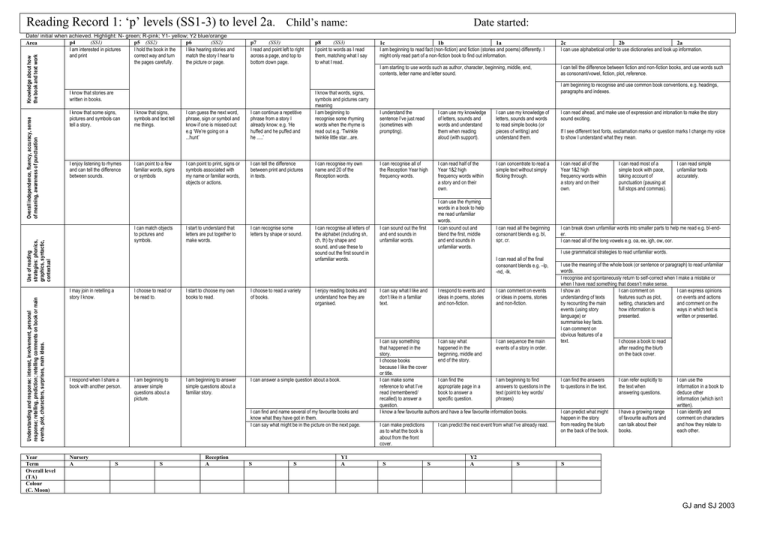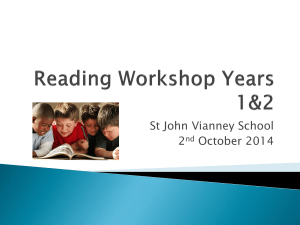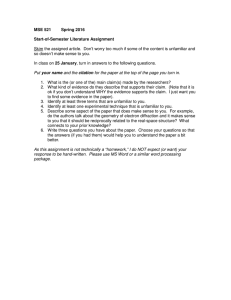Document 15654748
advertisement

Reading Record 1: ‘p’ levels (SS1-3) to level 2a. Child’s name: Understanding and response: interest, involvement, personal response; retelling, prediction; retelling comments on book or main events. plot, characters, surprises, main ideas. Year Term Overall level (TA) Colour (C. Moon) p7 (SS3) I read and point left to right across a page, and top to bottom down page. p8 (SS3) I point to words as I read them, matching what I say to what I read. I can guess the next word, phrase, sign or symbol and know if one is missed out: e.g ‘We’re going on a ...hunt’ I can continue a repetitive phrase from a story I already know: e.g. ‘He huffed and he puffed and he .....’ I know that words, signs, symbols and pictures carry meaning I am beginning to recognise some rhyming words when the rhyme is read out e.g. ‘Twinkle twinkle little star...are. I can point to print, signs or symbols associated with my name or familiar words, objects or actions. I can tell the difference between print and pictures in texts. I can recognise my own name and 20 of the Reception words. I know that stories are written in books. I know that some signs, pictures and symbols can tell a story. I enjoy listening to rhymes and can tell the difference between sounds. I know that signs, symbols and text tell me things. I can point to a few familiar words, signs or symbols I can match objects to pictures and symbols. Use of reading strategies: phonics, graphics, syntactic, contextual Overall independence, fluency, accuracy, sense of meaning, awareness of punctuation Knowledge about how the book and text work Date/ initial when achieved. Highlight: N- green; R-pink; Y1- yellow; Y2 blue/orange p4 (SS1) p5 (SS2) p6 (SS2) Area I am interested in pictures I hold the book in the I like hearing stories and and print correct way and turn match the story I hear to the pages carefully. the picture or page. I may join in retelling a story I know. I choose to read or be read to. I respond when I share a book with another person. I am beginning to answer simple questions about a picture. I start to understand that letters are put together to make words. I start to choose my own books to read. I am beginning to answer simple questions about a familiar story. I can recognise some letters by shape or sound. I choose to read a variety of books. S S Reception A S 2c 2b 2a I can use alphabetical order to use dictionaries and look up information. I am starting to use words such as author, character, beginning, middle, end, contents, letter name and letter sound. I can tell the difference between fiction and non-fiction books, and use words such as consonant/vowel, fiction, plot, reference. I am beginning to recognise and use common book conventions, e.g. headings, paragraphs and indexes. I understand the sentence I’ve just read (sometimes with prompting). I can use my knowledge of letters, sounds and words and understand them when reading aloud (with support). I can use my knowledge of letters, sounds and words to read simple books (or pieces of writing) and understand them. I can read ahead, and make use of expression and intonation to make the story sound exciting. I can recognise all of the Reception Year high frequency words. I can read half of the Year 1&2 high frequency words within a story and on their own. I can concentrate to read a simple text without simply flicking through. I can read all of the Year 1&2 high frequency words within a story and on their own. I can read all the beginning consonant blends e.g. bl, spr, cr. I can break down unfamiliar words into smaller parts to help me read e.g. bl-ender. I can read all of the long vowels e.g. oa, ee, igh, ow, oor. I can use the rhyming words in a book to help me read unfamiliar words. I can sound out and blend the first, middle and end sounds in unfamiliar words. I can sound out the first and end sounds in unfamiliar words. I enjoy reading books and understand how they are organised. I can say what I like and don’t like in a familiar text. I can answer a simple question about a book. S 1c 1b 1a I am beginning to read fact (non-fiction) and fiction (stories and poems) differently. I might only read part of a non-fiction book to find out information. I can recognise all letters of the alphabet (including sh, ch, th) by shape and sound, and use these to sound out the first sound in unfamiliar words. I can find and name several of my favourite books and know what they have got in them. I can say what might be in the picture on the next page. Nursery A Date started: Y1 A I can comment on events or ideas in poems, stories and non-fiction. I can say something I can say what I can sequence the main that happened in the happened in the events of a story in order. story. beginning, middle and end of the story. I choose books because I like the cover or title. I can make some I can find the I am beginning to find reference to what I’ve appropriate page in a answers to questions in the read (remembered/ book to answer a text (point to key words/ recalled) to answer a specific question. phrases) question. I know a few favourite authors and have a few favourite information books. I can make predictions as to what the book is about from the front cover. S I can predict the next event from what I’ve already read. S Y2 A I can read most of a simple book with pace, taking account of punctuation (pausing at full stops and commas). I can read simple unfamiliar texts accurately. I use grammatical strategies to read unfamiliar words. I can read all of the final consonant blends e.g. –lp, -nd, -lk. I respond to events and ideas in poems, stories and non-fiction. If I see different text fonts, exclamation marks or question marks I change my voice to show I understand what they mean. S I use the meaning of the whole book (or sentence or paragraph) to read unfamiliar words. I recognise and spontaneously return to self-correct when I make a mistake or when I have read something that doesn’t make sense. I show an I can comment on I can express opinions understanding of texts features such as plot, on events and actions by recounting the main setting, characters and and comment on the events (using story how information is ways in which text is language) or presented. written or presented. summarise key facts. I can comment on obvious features of a text. I choose a book to read after reading the blurb on the back cover. I can find the answers to questions in the text. I can refer explicitly to the text when answering questions. I can predict what might happen in the story from reading the blurb on the back of the book. I have a growing range of favourite authors and can talk about their books. I can use the information in a book to deduce other information (which isn’t written). I can identify and comment on characters and how they relate to each other. S GJ and SJ 2003



